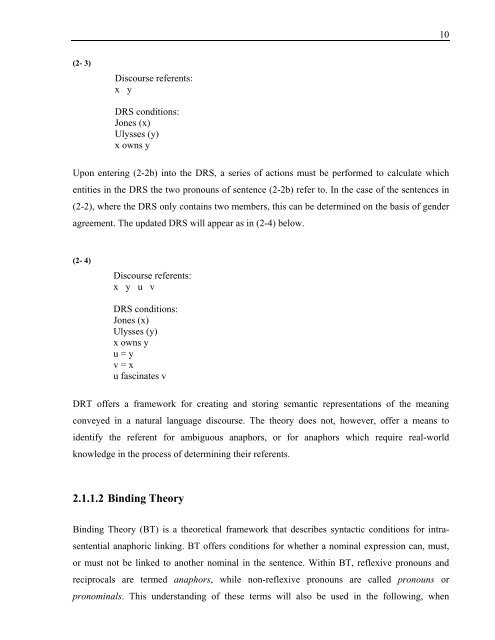Unni Cathrine Eiken February 2005
Unni Cathrine Eiken February 2005
Unni Cathrine Eiken February 2005
Create successful ePaper yourself
Turn your PDF publications into a flip-book with our unique Google optimized e-Paper software.
(2- 3)<br />
Discourse referents:<br />
x y<br />
DRS conditions:<br />
Jones (x)<br />
Ulysses (y)<br />
x owns y<br />
Upon entering (2-2b) into the DRS, a series of actions must be performed to calculate which<br />
entities in the DRS the two pronouns of sentence (2-2b) refer to. In the case of the sentences in<br />
(2-2), where the DRS only contains two members, this can be determined on the basis of gender<br />
agreement. The updated DRS will appear as in (2-4) below.<br />
(2- 4)<br />
Discourse referents:<br />
x y u v<br />
DRS conditions:<br />
Jones (x)<br />
Ulysses (y)<br />
x owns y<br />
u = y<br />
v = x<br />
u fascinates v<br />
DRT offers a framework for creating and storing semantic representations of the meaning<br />
conveyed in a natural language discourse. The theory does not, however, offer a means to<br />
identify the referent for ambiguous anaphors, or for anaphors which require real-world<br />
knowledge in the process of determining their referents.<br />
2.1.1.2 Binding Theory<br />
Binding Theory (BT) is a theoretical framework that describes syntactic conditions for intrasentential<br />
anaphoric linking. BT offers conditions for whether a nominal expression can, must,<br />
or must not be linked to another nominal in the sentence. Within BT, reflexive pronouns and<br />
reciprocals are termed anaphors, while non-reflexive pronouns are called pronouns or<br />
pronominals. This understanding of these terms will also be used in the following, when<br />
10

















